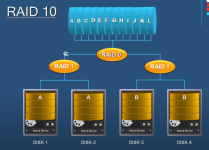@L&LD
It's more about perspective here though. What can you NOT live without a copy of is usually pretty limited and could be shuffled off to Google Drive or DropBox for free. Google gives you 15GB of space for free and if you need more just make another account.
At least with R10 you have a mirror + stripe vs dealing with parity recovery from R6.
With the drives though it's best to pick what you can afford and do it right the first time rather than dealing with data migration later when you decide to expand. While R10 isn't a "backup" it's enough to keep your data safe provided you don't physically blow up the PC or the drives. The thing to think about is diversifying the sources of the drives so you don't buy a single batch that might have issues later on that may cause failures of multiple drives at the same time.
Having a USB enclosure with a 16TB drive to backup the Raid10 would be optimal but, that can be postponed a bit due to it running another ~$250 for the drive + enclosure
Comparison of all hard drives and SSDs on Amazon, sorted by price per TB

diskprices.com
Or in my case I just use a USBC <> SATA cable w/ a wall wart for 3.5 drives
https://www.amazon.com/gp/product/B071GRCGF4/?tag=snbforums-20 - ~$50


